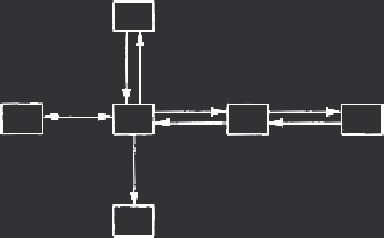Agriculture Reference
In-Depth Information
S
1
k
2
k
1
k
3
k
5
K
f
S
e
S
2
S
3
C
k
4
k
6
k
s
S
irr
FIGURE 5.4
A schematic representation of the multireaction model.
the solution phase and are governed by concurrent type reactions. Here we
assume
S
e
is the amount of solute that is sorbed reversibly and is in equilib-
rium with C at all times. Specifically, the multireaction model assumes that
the total amount sorbed
S
T
or simply S is the total amount retained reversibly
or reversibly by soil matrix surfaces,
S
=++++
.
The governing equilibrium retention/release mechanism is the nonlinear
Freundlich type:
SSSSS
e
1
2
3
irr
S
=
K
b
C
(5.6)
e
f
where
K
f
is the associated distribution coefficient (cm
3
kg
-1
) and
b
is a dimen-
sionless Freundlich parameter (
b
< 1). Other equilibrium-type retention
mechanisms are given in Chapter 3. These include linear (
b
= 1), Langmuir,
two-site Langmuir, and others.
The retention/release reactions associated with
S
1
,
S
2
, and
S
3
are concur-
rent- or consecutive-type kinetic reactions. Specifically, the
S
1
and
S
2
phases
were considered to be in direct contact with
C
and reversible rate coefficients
of the (nonlinear) kinetic type govern their reactions:
∂
∂
S
t
Θ
ρ
1
=
n
−
k
C
k S
(5.7)
1
2
1
∂
∂
S
t
Θ
ρ
−+ +
2
=
m
(
)
(5.8)
k
C
kkS
k S
3
4
5
2
6
3
∂
∂
S
t
3
=
−
k S
k S
(5.9)
5
2
6
3
where
k
1
and
k
2
are the forward and backward rate coefficients (h
-1
), respec-
tively, and
n
is the reaction order associated with
S
1
. Similarly,
k
3
and
k
4
are




Search WWH ::

Custom Search